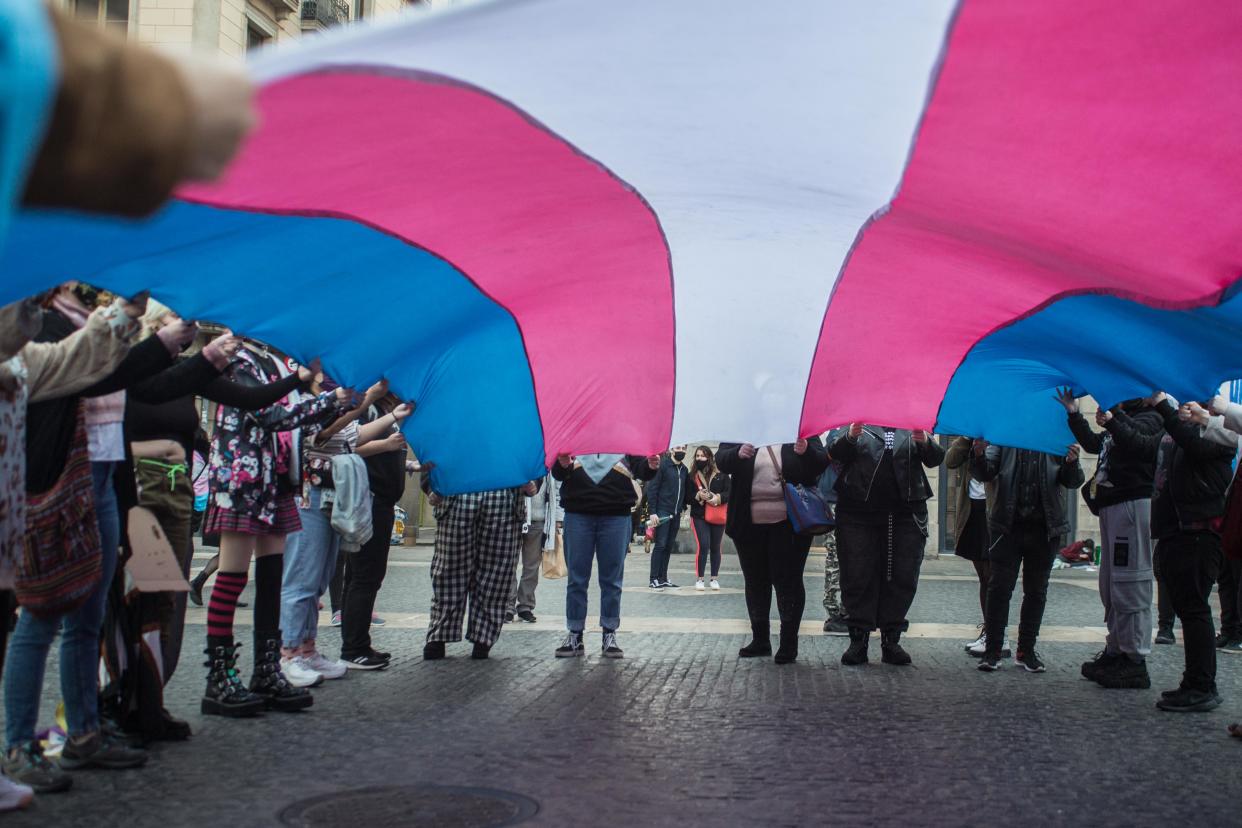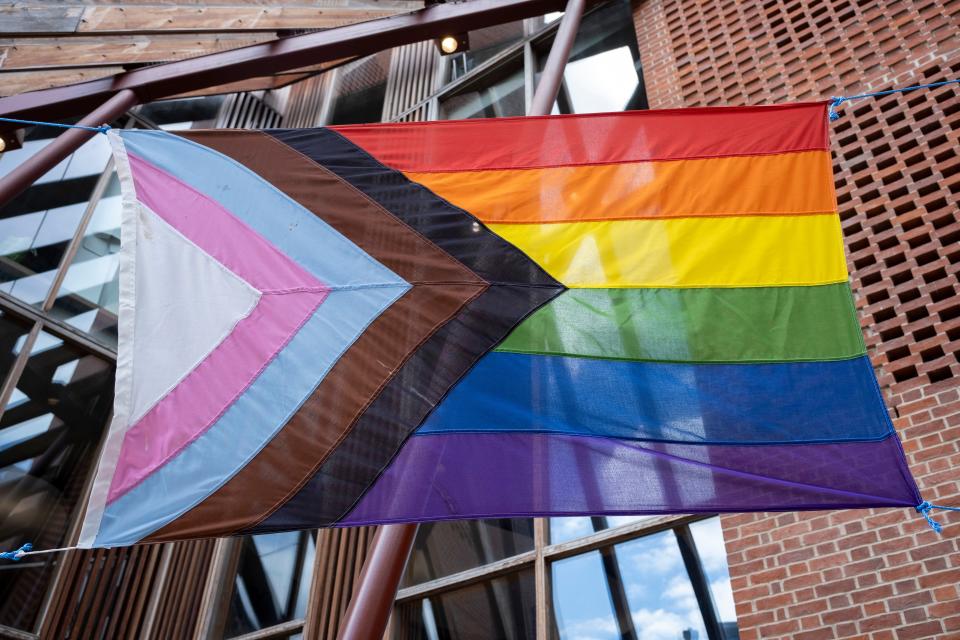Trans Flag: Breaking Down the Colors and Its History

SOPA Images/Getty Images
Flags are a simple way to celebrate and demonstrate support for a community For the LGBTQ+ community, Pride flags serve as a tool to demarcate community spaces and businesses that are queer-friendly, and as a public way to encourage others to live freely as themselves. While the classic rainbow-adorned flag created by Gilbert Baker is the most common Pride flag you’ll see, often representing the LGBTQ+ community as a whole, there are symbols for every facet of the identity spectrum. For example, you’re most likely to see the pink, blue, and white trans flag throughout Transgender Awareness Week, which occurs every year between November 13 and 19, but it’s gaining popularity as more and more people speak openly about their gender journeys and experiences. Transgender is a term that defines people who identify as a different gender than what they were assigned at birth. The umbrella term focuses on gender identity more than sexuality.
With anti-trans legislation being introduced in statehouses throughout the country, and politicians targeting trans youth, flying the transgender Pride flag is a way to proudly stand up for trans rights. As of 2024, 597 anti-trans bills are still being considered across the U.S., which would impact healthcare access, student-athletes, military members, incarcerated people, and more, according to Trans Legislation Tracker. 42 anti-trans bills were passed in 2024, on top of the 87 passed in 2023.
The trans flag is relatively young, having only been introduced in the late ‘90s, but it represents a massive group of people. According to a study from the Pew Research Center in June 2022, 1.6% of adults in the United States identify as transgender or nonbinary and 5% of young adults in the U.S. say their gender is different from their sex assigned at birth. A recent Gallup poll found that 7.6% of adults in the U.S. identify as part of the LGBTQ+ community, which is up from 3.5% in 2012.
But where did the trans flag come from? Who created the trans flag? Ahead, we break down the origins and meaning behind it.
The History of the Trans Flag
We can thank Monica Helms, a trans woman who is both a U.S. Navy veteran and trans activist, for the flag that celebrates the trans community. Helms first designed the flag in 1999 and introduced it at a Phoenix Pride parade in 2000. The flag is a symbol of trans pride and diversity and has since become a universal badge of joy and acceptance. It’s displayed at Pride events, in homes, at businesses, on t-shirts—the list goes on and on.
The flag has since become incorporated into other Pride flag designs — including the Progress Pride flag, which was created by Daniel Quasar in 2018. The flag incorporates Helms’ trans flag with the traditional rainbow Pride flag made by Gilbert Baker, and includes elements of Philadelphia and Seattle’s Pride flags.
“I had an epiphany that all of these flags matter to each person and they’re flying them for their own reasons,” Qausar told The Trevor Project in an interview. “It just shows the grand diversity and sheer individualism that we have within our community that is so beautiful.”

Pride Progress Flag In London
If you’re looking to get a peek at the original flag, Helms donated it to the Smithsonian National Museum of American History, where visitors can see the design on display in the LGBT collection.
What Do the Colors of the Trans Flag Mean?
As with all other flags, you have to know what the colors symbolize to fully appreciate the design. The trans flag is relatively simple when it comes to color palette, with five horizontal stripes and three main hues: pink, blue, and white. Each color encapsulates a different part of the trans community, coming together in one cheery banner. The flag was designed so that there is no upside-down version of the arrangement—no matter which way it’s flown, the same image appears. This was done intentionally to add another layer of meaning to the flag: There is no wrong way to hang the flag, just as there is no wrong way to express your gender identity
What does the pink represent?
According to traditional societal rules, pink is often associated with girls. This color is incorporated to celebrate anyone who identifies as a woman, despite the gender they were assigned at birth.
What does the blue represent?
Similarly to the pink addition, blue is a nod to society’s association of the color with boys. You guessed it: The color celebrates anyone who identifies as a man, despite the gender they were assigned at birth.
What does the white represent?
Gender is not constricted by the binary of boy or girl, man or woman. With this in mind, Helms wanted to celebrate the broader LGBTQ+ community in the design. The central white stripe is in honor of people who identify as intersex, transitioning, or don’t have a pre-defined gender.
Are there other LGBTQ flags?
Of course! No matter how you identify, there is an LGBTQ+ symbol celebrating you and your community. From asexual flags and bisexual flags to pansexual flags and everything in between, the collection of Pride emblems is as varied as the people who make up the community. The rainbow-hued gay pride flag you see most commonly at parades and other events is only the beginning.
There are also a handful of variations on the trans flag, designed by members of the community. For example, genderqueer writer and advocate Marilyn Roxie put together a flag for genderqueer folx. This design has a lavender stripe at the top — a mix of blue and pink — that’s used to represent androgyny. (Lavender is a color that has long been associated with queer identity.) The second strip is white and holds a similar meaning to the white strip in the trans flag. The third and final strip is dark green, the opposite color to lavender on the color wheel, which represents anyone who identifies outside of the traditional gender spectrum.
Originally Appeared on Teen Vogue
Want to read more Teen Vogue LGBTQ coverage?

